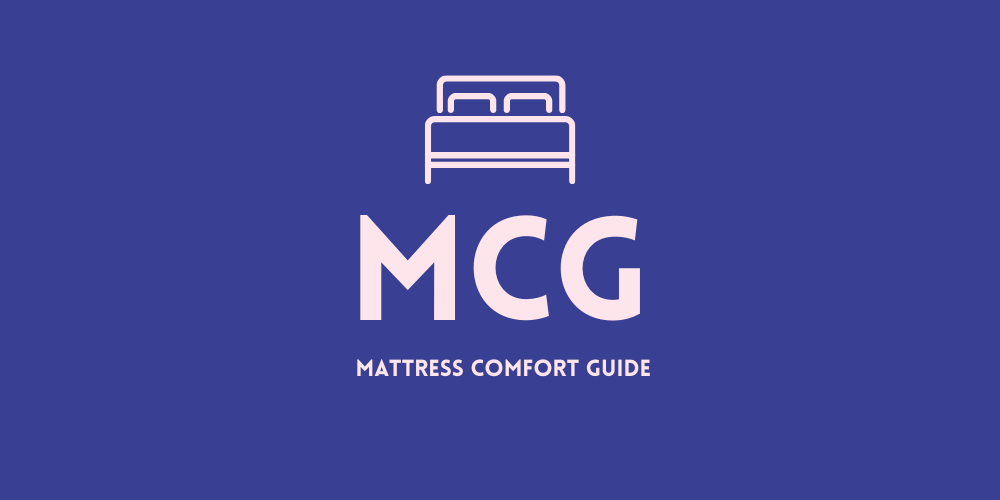
A latex mattress should be 8” to 12” inches thick. The best thickness for a latex mattress will be influenced by several factors including preferred sleeping position, body size, and personal preference.
For example, side sleepers will feel more comfortable on a thicker latex mattress as it provides more pressure relief. And, a lightweight individual will prefer a thinner mattress as a thinner mattress provides the optimal support and cushioning needed.
Our expert guide below covers everything you need to know about choosing the best latex mattress thickness for your individual needs.
WHAT IS THE BEST THICKNESS FOR A LATEX MATTRESS?
Want to get to something quickly? Use the links below to jump to what you need to know.
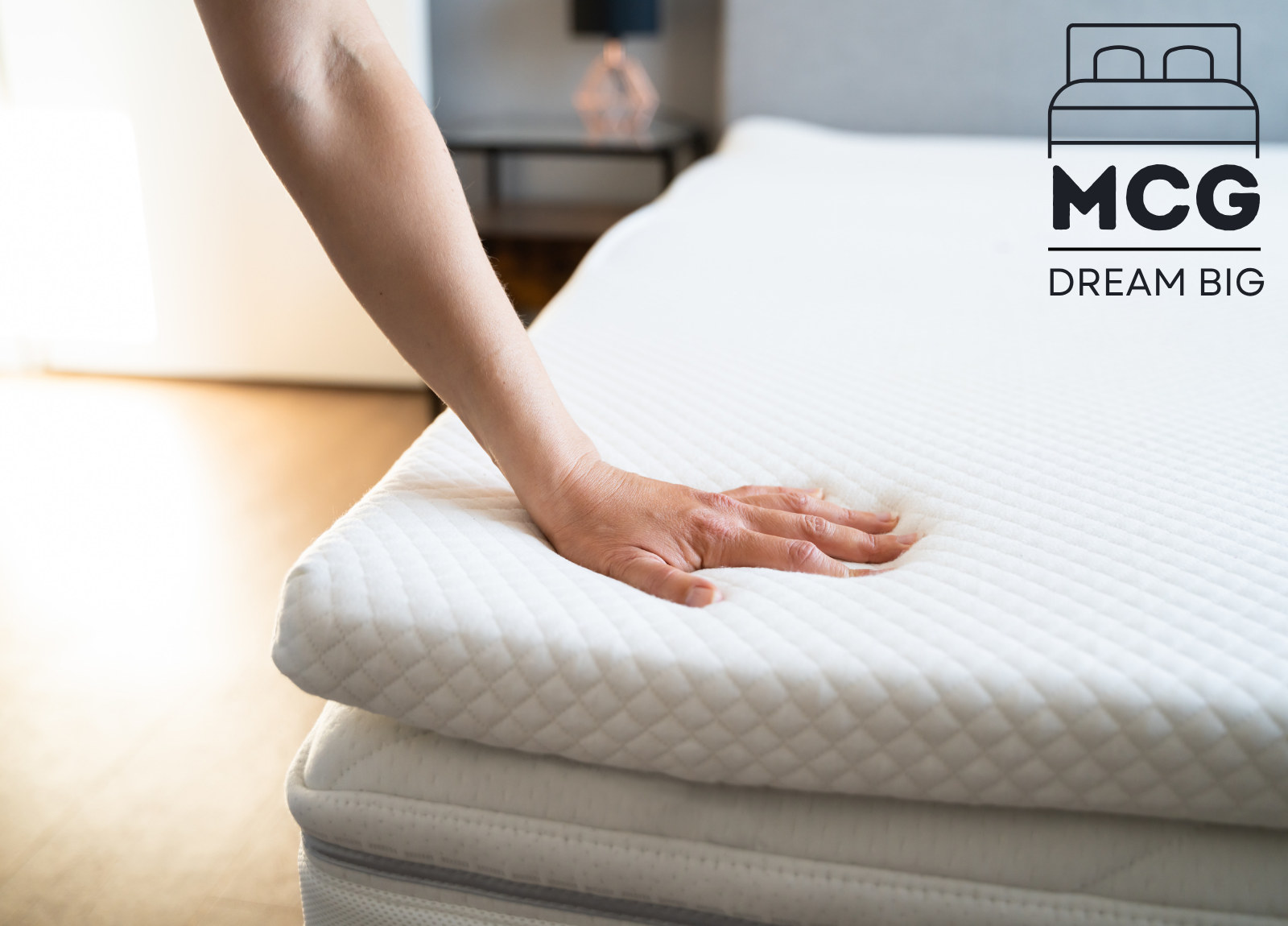
• Underlying Health Conditions
SLEEPING POSITION
First up, is sleeping position. When it comes to figuring out how thick a latex mattress should be you need to consider your preferred sleeping position. Are you a side sleeper, back sleeper, or stomach sleeper? If you are a combination sleeper, which position do you spend the most time in?
Mattress Thickness Guide
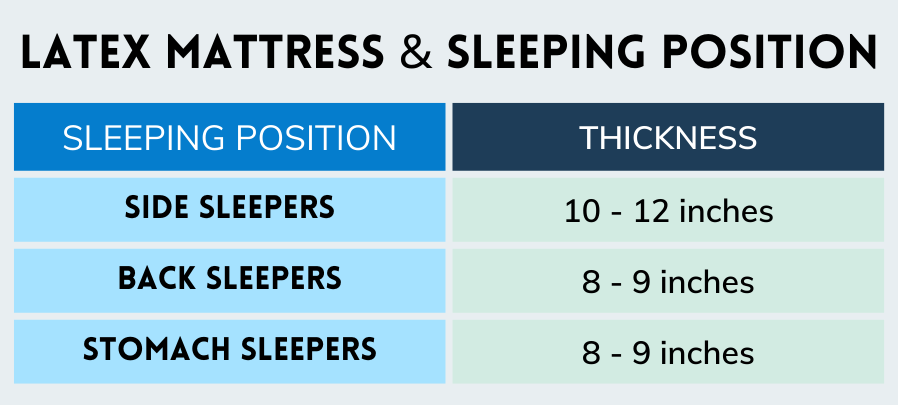
SIDE SLEEPERS
Side sleepers need a thicker latex mattress with plenty of cushioning. This sleeping position needs a mattress that relieves pressure on the hips and knees. Side sleepers feel more comfortable on a mattress with a plush feel and lots of soft padding. A latex mattress with a medium-soft feel and a thickness of 10 – 12 inches works best for side sleeping.
BACK SLEEPERS
Back sleepers need a mattress with more support and a slightly more firm feel. Medium-thick latex mattresses are best for back sleeping. The best thickness for this sleeping position is 8 – 9 inches. These latex mattresses provide a firm feel that helps keep the back straight and promotes spinal alignment. Additionally, mattresses with strong edge support are good for back sleepers as they provide a consistently flat sleeping surface.
STOMACH SLEEPERS
Stomach sleepers need a firm-feeling mattress with strong support. People who sleep on their stomachs need to rest on the surface of the mattress without sinking into it. Thinner mattresses with a firm feel benefit stomach sleepers. If you favor this sleeping position, you should aim for a latex mattress with a thickness of 8 – 9 inches.
BODY SIZE
Does mattress thickness matter? Yes, the best thickness of a latex mattress is largely determined by the body size of the individual, specifically body weight. Lighter individuals will feel more comfortable on a thinner latex mattress. And, heavyweight people need more support and will benefit from a thicker mattress. To explain the role body weight plays in choosing the Best Latex Mattress, we have created 3 general weight categories. Take a look at the chart below.
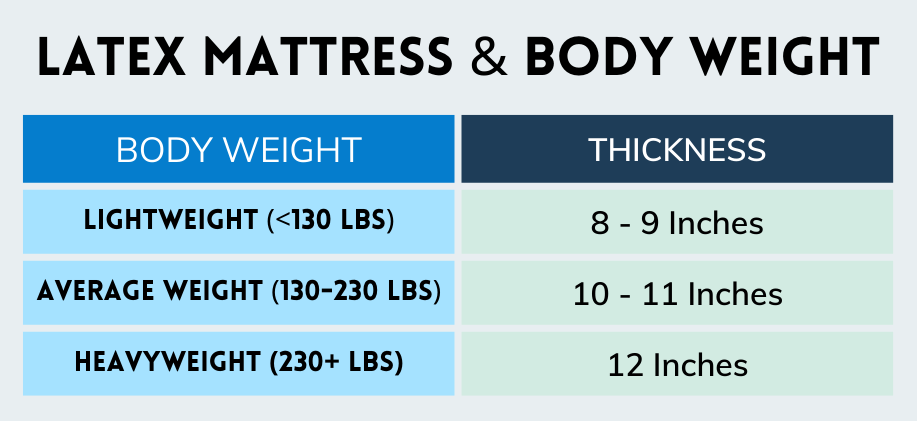
LIGHTWEIGHT (Less Than 130 Pounds)
Lightweight individuals will feel more comfortable on a thinner latex mattress. These people need less support and less soft cushioning as there is less weight pressing down into the surface of the mattress. Anyone weighing below 130 pounds will feel most comfortable on thinner latex mattresses with a depth of between 8 to 9 inches.
AVERAGE WEIGHT (130 to 230 Pounds)
Average weight people who weigh between 130 pounds and 230 pounds should choose a medium-thick latex mattress. These people will feel most comfortable on a latex mattress with a height of 10 to 11 inches. This mattress provides plenty of cushioning foam to cradle body weight and relieve pressure on areas such as the hips, knees, and shoulders.
HEAVYWEIGHT (Above 230 Pounds)
Heavyweight people need a mattress that delivers greater support, stability, and cushioning. Individuals weighing more than 230 pounds need a thicker, more robust mattress compared to regular-sized people. Anyone that falls into this category should aim for a latex mattress with a thickness of 12 inches.
READ NEXT
• The Best Latex Mattress 2025
TYPE OF LATEX
NATURAL, SYNTHETIC & BLENDED
There are three types of latex mattress on the market – Natural Latex, Synthetic Latex, and Blended Latex. Natural latex mattresses are made using the sap of the rubber tree and have a more bouncy feel compared to synthetic latex. Synthetic latex mattresses are made using a synthetic material that mimics the feel of natural latex. The material is called SBR – Styrene-Butadiene Rubber.
If you plan on purchasing a synthetic mattress you should add an inch to your preferred thickness to match the same feel and responsiveness of an all-natural latex mattress. Blended latex mattresses use a combination of both natural and synthetic latex foam.
TALALAY & DUNLOP LATEX
Then there are Talalay and Dunlop latex mattresses. Two types of latex foam. They involve two different manufacturing techniques for assembling the latex mattress. A Dunlop latex mattress is made using a single pour of latex foam into a mold that is allowed to set. Talalay mattresses involve multiple pour stages and the possible addition of extra materials. For more, check out our full guide What Is a Latex Mattress?
LATEX FOAM DENSITY CHART
Latex foam density plays a key role in the feel and performance of a latex mattress. When assessing mattress height and thickness – you should also pay attention to the foam density of a mattress and how it will affect the support, cushioning, and feel of a mattress.
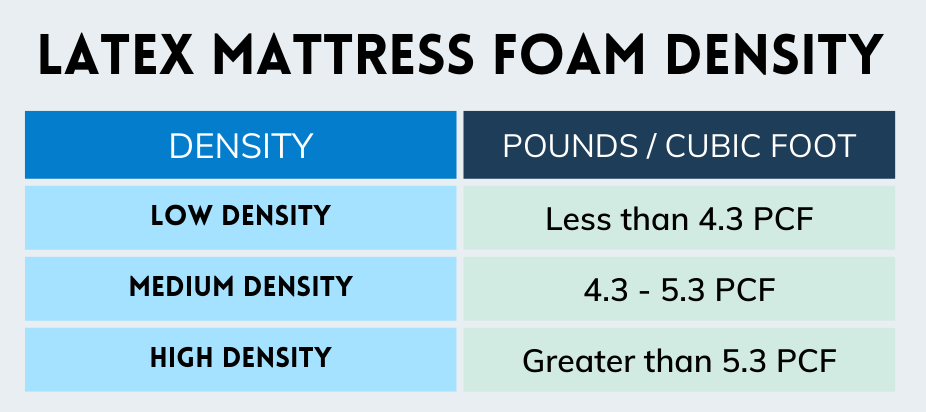
Latex mattress foam density is measured in PCF (Pounds per Cubic Foot). The higher the value, the denser the foam. High-density foam has a firmer feel compared to low-density. High-density foam resists compression and provides strong, stable support. Low-density latex foam has a soft feel and is used to deliver soft cushioning.
Lightweight people will feel more comfortable on a lower-density foam compared to heavy-weight individuals. The table below outlines how the numerical values of PCF are applied to latex foam density.
WHAT ABOUT COUPLES?
Do couples need to consider mattress thickness when choosing a latex mattress? In short, yes. When two people sleep in a bed the weight the mattress has to bare is greater. This has an impact on how the mattress performs and can affect the expected lifespan of the mattress.

In general, latex mattresses are high-end products. They come with a higher price tag compared to other mattress types. However, they are durable and have a greater life expectancy. However, couples tend to wear out a mattress more quickly compared to a solo sleeper.
This means you should add a little thickness when choosing a mattress for a couple. Our advice is to add 1-inch in latex foam thickness if the mattress is going to be used by a couple. Not only will this increase lifespan and durability, but it will add additional support and help prevent the mattress from sagging around the edges. Good news all-round.
RELATED
• Is a Latex Mattress Waterproof?
• Pros & Cons of Latex Mattress
• How to Clean a Latex Mattress
UNDERLYING HEALTH CONDITIONS
Underlying conditions play a role in determining the best mattress thickness for an individual. Anyone suffering from fibromyalgia, chronic joint pain, or arthritis will feel more comfortable on a soft mattress with lots of plush cushioning. These individuals should choose a thicker mattress with a soft feel.
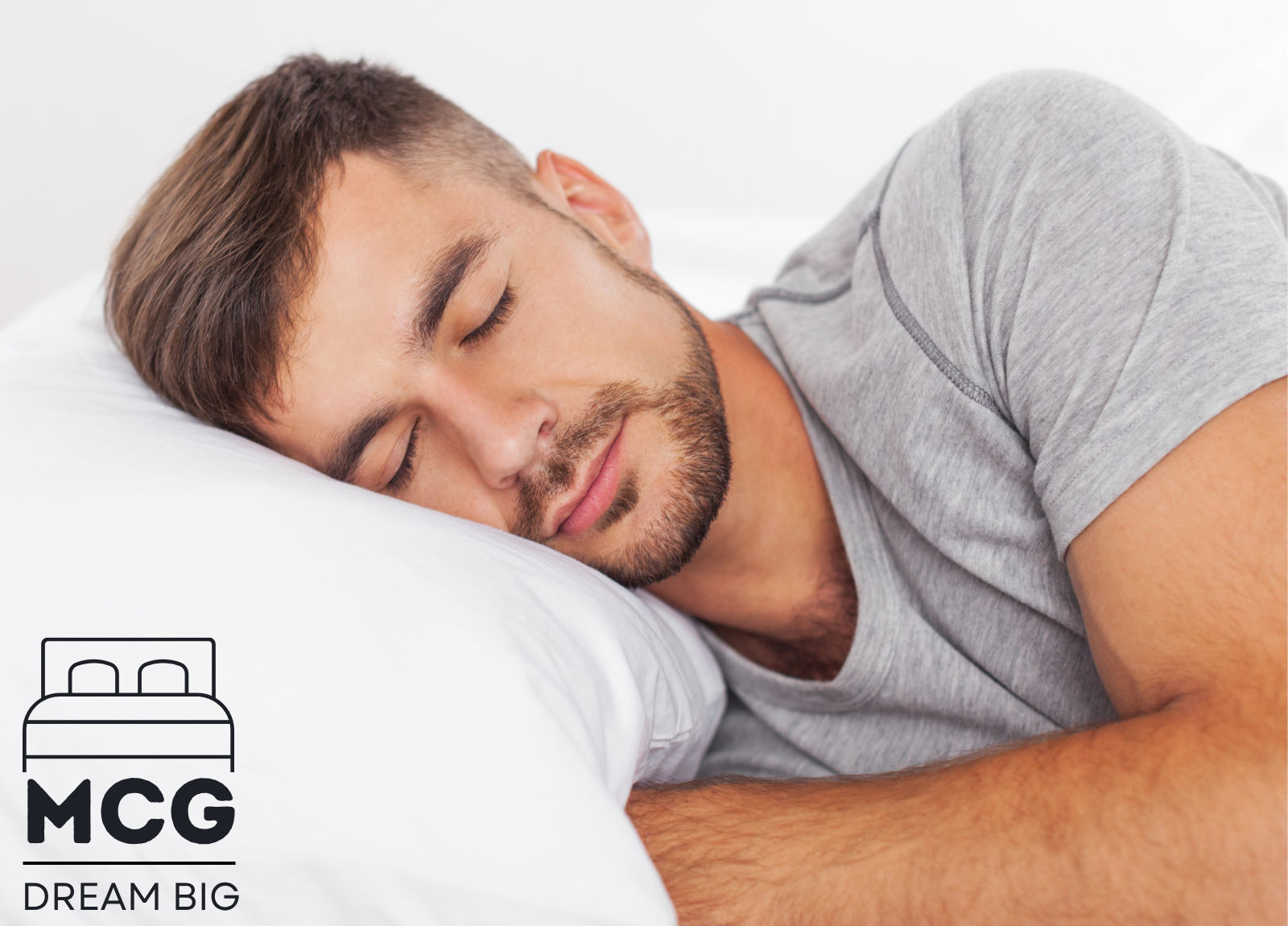
On the other hand, people that suffer from back pain – especially lumbago – will feel more comfortable on a firm mattress that provides rigid support. Thin latex mattresses work best here as they have a thinner comfort layer that brings the lumbar region into closer proximity to the firm base below. An 8” to 10” inch thick mattress works best for people suffering from pain in the lumbar region.
OVERALL BED PROFILE
When deciding how thick should a latex mattress be – you must consider the overall bed profile. This refers to the height of your bed, from the top of the mattress to the floor of the room. The standard profile for a bed and mattress is 25” inches.
This is the height that most people find comfortable. To determine the profile of your bed simply grab a tape measure and measure the height from the top of the bedframe (where the mattress will rest) to the floor. Then add the thickness of the mattress you are planning to purchase.
Thick latex mattresses will give you a higher bed profile and lower mattresses a smaller profile. As to which profile works best for you – it all comes down to personal preference. Some people find it easier to climb in and out of a bed with a low profile, while others prefer something higher.
PRICE TAG
Thick latex mattresses are more expensive than thin alternatives. If you are on a budget you should aim for a thinner, high-quality latex mattress, with a medium to medium-high foam density. Thick mattresses contain more foam than thinner varieties – and this adds to their cost.
Additionally, natural latex mattresses cost more than synthetic models. If you want a thick latex mattress but can’t afford the associated price tag – take a look at blended and synthetic products. You’ll find these much more affordable and they may allow you to obtain the plush mattress thickness of your dreams.
PROS & CONS OF A THICK LATEX MATTRESS
What are the pros and cons of a thick latex mattress? The key advantages of a thick latex mattress are they are great for side sleepers, and couples, and feel super comfortable for medium and heavyweight individuals. On the other hand, the key disadvantages are their price, high bed profile, and may not work well for back and stomach sleepers.
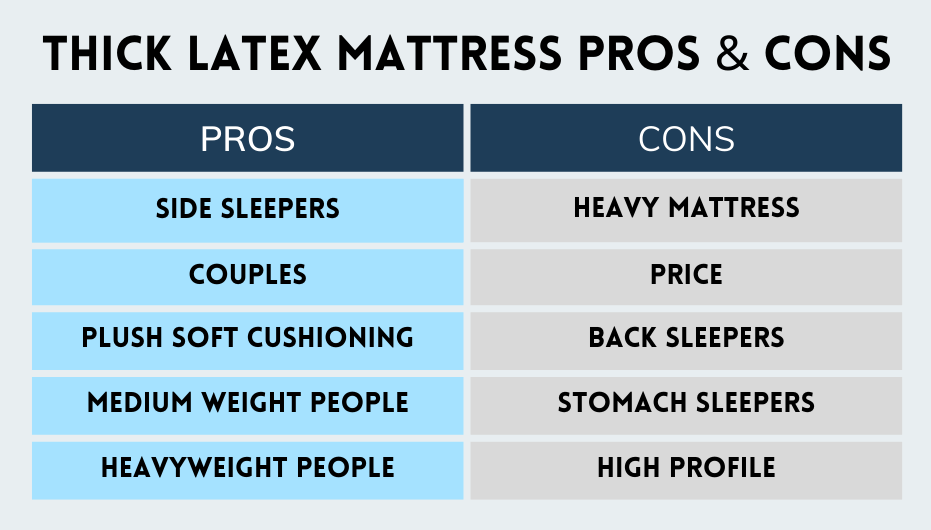
PROS & CONS OF A THIN LATEX MATTRESS
What are the pros and cons of a thin latex mattress? The key advantages of a thin latex mattress are they are great for back and stomach sleeping positions, they work well for solo sleepers, and are particularly suitable for people suffering from lower back pain. The key disadvantages are how they may not work well for side sleepers, people with chronic pain and inflammation, and can wear more quickly when used by couples.

READ NEXT
• What Is a Talalay Latex Mattress?
• Latex Mattress vs Memory Foam
• Natural vs. Synthetic Latex Mattress
• How Long Does a Latex Mattress Last?
FAQ
How Thick Should a Mattress Be?
A latex mattress should be between 8” inches and 12” inches thick. This is the best thickness for a latex mattress. Factors that influence the best thickness include sleeping position, your body size, and personal preference for mattress feel.
What is the Average Mattress Thickness for a Latex Mattress?
Most people aim for a mattress thickness of 10″ to 12″ inches for latex mattresses. This is the most popular and best selling size. Your ideal mattress thickness will be individual to you and your specific needs.
ABOUT THE AUTHOR
JESSICA GABEL – MCG Contributor
Jessica joined the MCG team in 2021 and is our in-house sleep expert. She is a fountain of knowledge on sleep cycles, sleep hygiene, and sleep-related disorders. Jessica is a graduate of the College of Arts and Sciences at the University of New Mexico and holds a B.S in Sociology.
When she’s not educating us on sleep-related matters she is continuing her studies at the University of Arizona. Outside of work and study, Jessica likes to explore the great outdoors. Her favorite places to visit include the White Sands National Park, Chaco Culture National Historical Park, and the Carlsbad Caverns National Park.
